Assessment of the Amputee
An amputation is defined as the removal of part or all of a limb or some other outgrowth of the body. If fingers and partial non-mutilating hand injuries are excluded, lower-limb amputations are much more frequent than upper-limb amputations.1 However, upper-limb amputations cause greater functional loss because the upper limbs are used more functionally and in many more diverse ways. There is also a greater functional sensory loss when an upper limb is involved. In addition, the upper-limb amputation causes a more obvious disfigurement and alteration of body image, which affects the actions and reactions of both the amputee and those with whom he or she interacts.1,2 Amputations are considered to be a treatment of last resort when other methods, such as revascularization or reattachment, have failed or are not considered suitable treatment options.2–5 Assessment of the amputee patient may involve assessing a patient before the amputation or after the amputation has taken place. In the first instance, the assessment is primarily carried out by one or more physicians deciding whether there is a need for such a procedure and then deciding the level at which the amputation should occur. In some cases, indexes or scores6–19 may be used although some20 have questioned their usefulness in the final outcome, especially in the case of trauma.
There are several indications for amputations.21 The most common are trauma caused by compound fractures, blood vessel rupture, stab or gunshot injuries, compression injuries, severe burns, or cold injuries;22 and vascular disease as the result of systemic problems, such as diabetes, arteriosclerosis, embolism, venous insufficiency, or peripheral vascular disease often aggravated by cigarette smoking.23 About 75% of amputations in older patients fall within this second category.24 The presence of suspected vascular disease may include more than the physical examination when considering whether to amputate. These other tests include blood tests, chest x-rays, electrocardiography, Doppler studies, arteriography, venograms, thermography, and transcutaneous PO2 readings.22 When trauma is the cause, the aim of the amputation is to restore maximum length with good soft-tissue covering.22 In addition, amputations may be performed because of infections, tumors (both benign and more commonly, malignant types), neurological disorders (e.g., an anaesthetic limb from, for example, a complete plexus avulsion25), congenital deformity (e.g., partial or total absence of a limb), and amputations for cosmetic reasons (e.g., extra digit).25–28 Younger people tend to experience more congenital, malignancy, and trauma-related amputations, whereas older people experience multiple pathophysiological mechanisms, as previously mentioned.
The examiner who has the opportunity to do a preoperative physical assessment of the patient who has been scheduled for an amputation should take the time to determine the patient’s available muscle strength, range of motion (ROM), and functional mobility bilaterally to provide a baseline for future comparison if necessary. The size and position of any abnormal tissue degeneration or potential pressure areas should be recorded accurately, and functional levels should be assessed and recorded. If at all possible in this preoperative period, the patient should be given some instruction in bed mobility, as well as climbing in and out of bed with or without support. In addition, the examiner should ensure that the patient knows how to provide suitable care for pressure areas and preserve joint mobility to prevent any contractures from forming. If a lower-limb amputation is anticipated, the patient should be taught to use ambulatory aids such as crutches or wheelchair so that he or she can maintain as much mobility as possible after the amputation.
Levels of Amputation
Amputation surgery, whether performed to the upper limb or the lower limb, can occur at various levels (Figures 16-1 and 16-2).29 For the most part, this chapter deals with assessment of the lower-limb amputee primarily, because these amputations are more common. However, functional loss is usually greater for upper-limb amputees. Thus upper-limb amputee assessment deals much more with different functional demands than lower-limb assessment. Figure 16-3 shows the percentage impairment caused by an upper-limb amputation.30
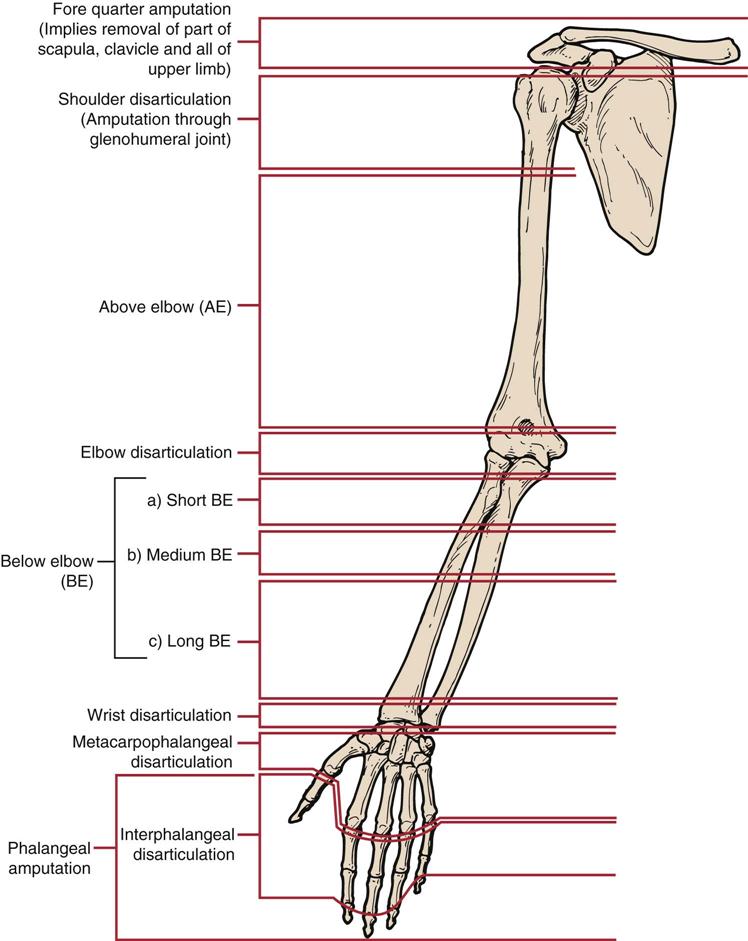
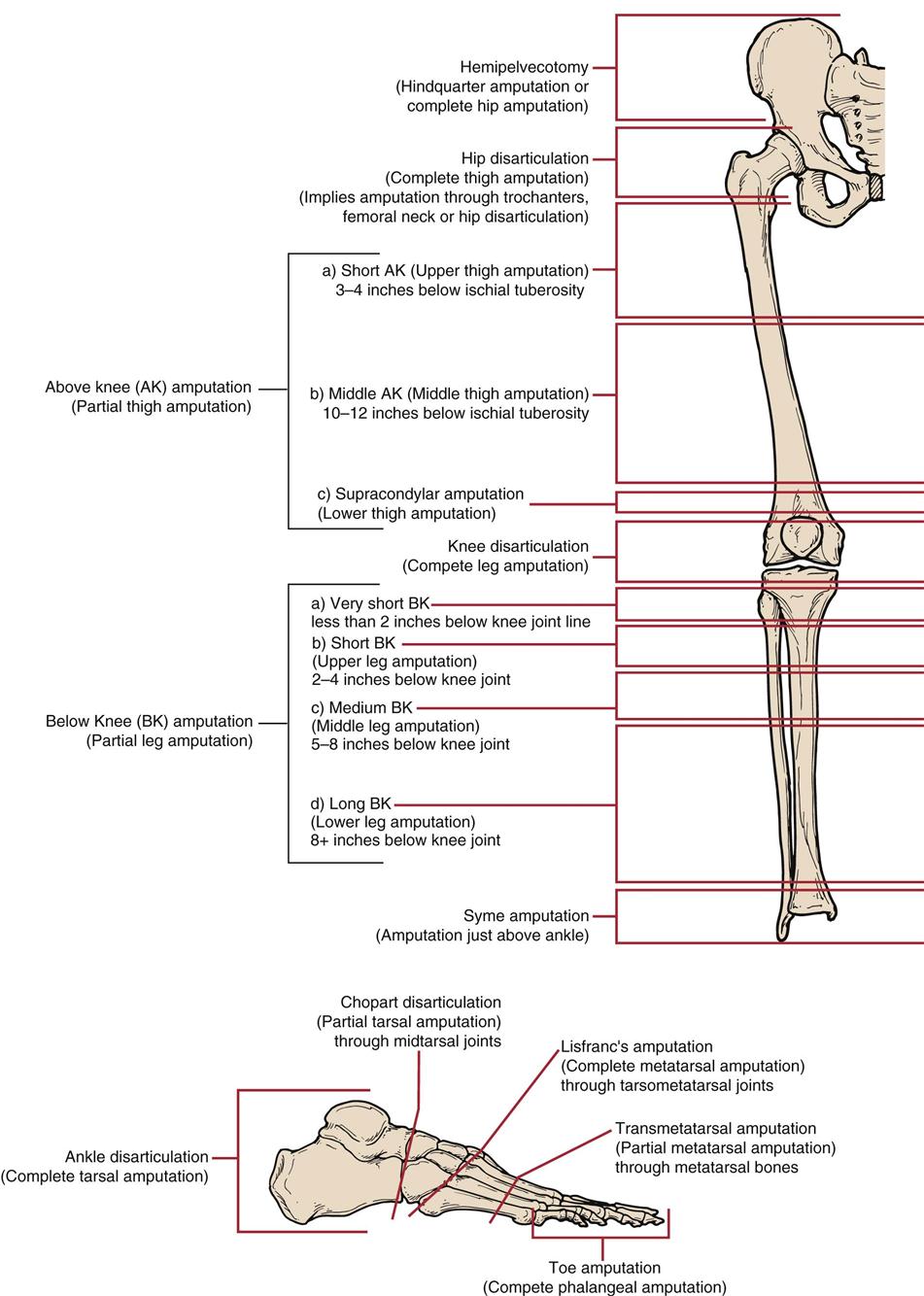
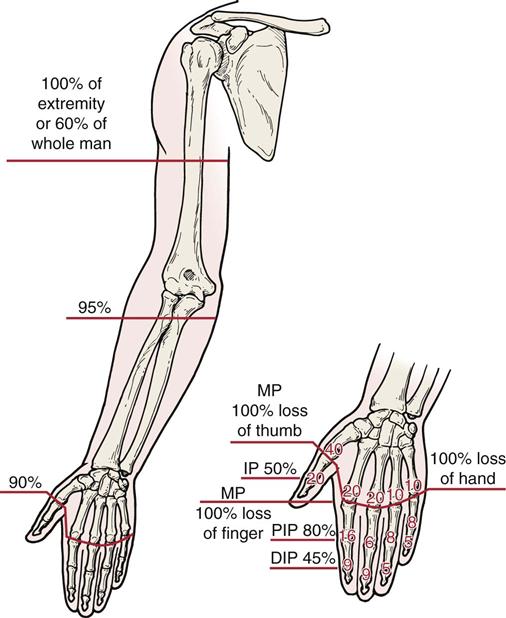
Percentage of impairments related to whole body, extremity, hand, or digit. DIP, Distal interphalangeal; IP, interphalangeal; MP, metacarpophalangeal; PIP, proximal interphalangeal. (Redrawn from Swanson AB, de Groot Swanson G, Goran-Hagert C: Evaluation of hand function. In Hunter JM, Schneider LH, Mackin EJ, et al, editors: Rehabilitation of the hand, St Louis, 1990, Mosby, p. 119.)
Amputation surgery may be one of two types—open or closed. Open, or primary, amputation is used in cases of infection in which the wound is left open after the amputated part is removed to allow clearance of infection. It requires a second procedure to close the wound. More commonly, a closed amputation is performed. This procedure is used when tissue viability is as normal as possible. At the time of the amputation, the skin flaps are closed, as is the wound. Commonly, the skin flaps are closed on the posterior and distal aspect of the stump because adhesions are less likely and an incision line is further from the bone, but other methods are also sometimes used.31 The goal of amputation surgery is to create a dynamically-balanced residual limb with good motor control and sensation.32 The patient will need a well-healed, well-shaped residual stump with the greatest functional length possible in the limb.32 The higher the level of the amputation, the greater the handicap.25 In the lower limb, immediate prosthetic fitting helps facilitate early mobilization with more normal gait patterns.26 Amputation should be considered to be a reconstructive procedure leaving the patient with the best of possible alternatives.33
The second opportunity where the amputee patient may be assessed is following the surgery. This is more likely to be done by the physician or other health care professionals. In this case, the aim of the assessment is primarily to determine what functional deficits the patient has, to assess the fitting of the prosthesis, and to watch for complications. A good assessment enables the clinician to assist the patient in understanding and dealing with the specific physical and social limitations that the amputation has brought to his or her pattern of life.34 This second scenario is described in the remainder of this chapter.
Patient History34
As with any assessment, the initial part of the examination will include the patient’s history as it relates to the amputation, its cause, and any related factors. When doing the assessment of the amputee, it is important to determine the patient’s past medical, surgical, preoperative ambulatory, and functional status for both upper and lower limbs, and preoperative symptoms. As part of this “past history,” the examiner must develop some understanding of the patient’s recreational activities, past psychiatric history (which may include information on alcohol or drug abuse), current stressors (including recent losses), pain tolerance, previous association with patients who have disabilities, and compliance with medical treatments.24 In addition, information on family structure and possible support groups, including family and friends, must be discussed. Issues such as marital status, sexual history, family roles including familial support, strengths, and problems should be ascertained, because they can impact greatly the outcome and how the patient ultimately functions as an amputee.35,36
The examiner must determine and develop an understanding for any patient anxieties, why they are present, whether these anxieties can be dealt with by the examiner or if other health care specialists need to be involved, what the patient imagines his or her future to be, and how the disability will change his or her lifestyle, social relations, vocational future, and self-concept (Table 16-1). All these factors must be considered if the examiner hopes to have a successful outcome to treatment.
TABLE 16-1
Patient Motivational and General Problems
| Problem | Cause | Findings | Solution |
| Discouraged patient | |||
| Failure to maintain good prosthetic habits | |||
| Poor hygiene | |||
| Rest pain | |||
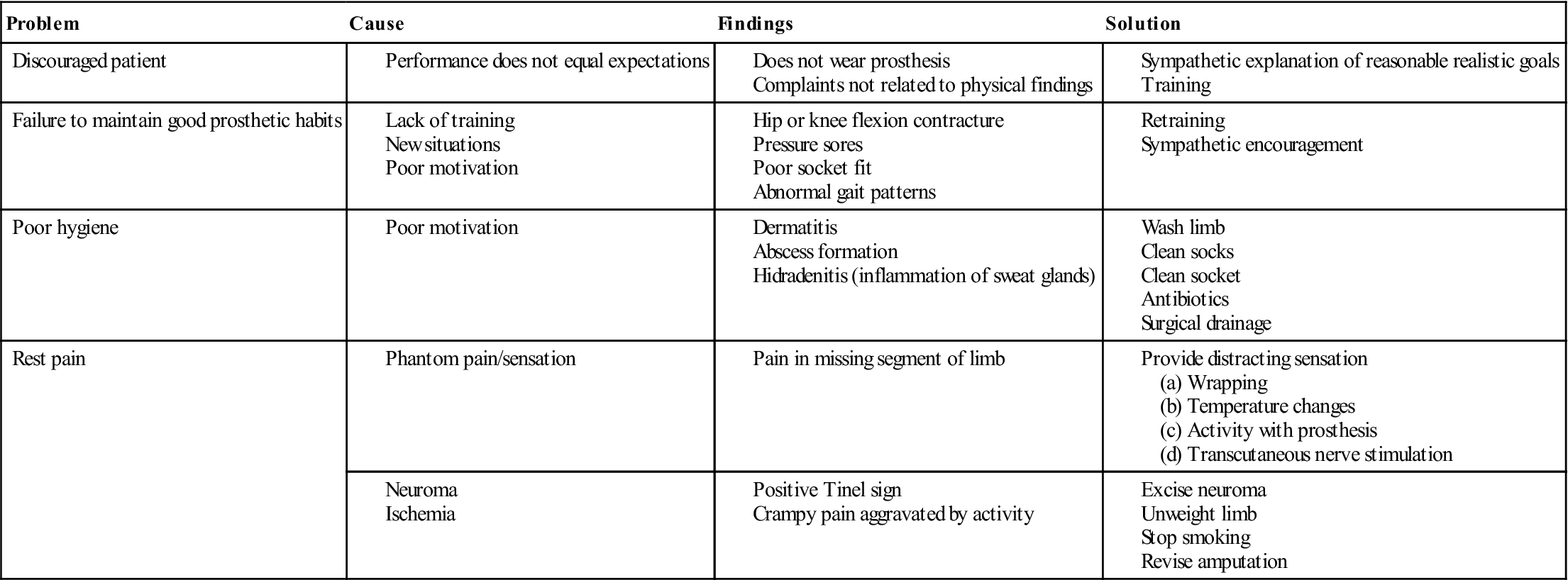
Modified from Smith AG: Common problems of lower extremity amputees. Orthop Clin North Am 13:576, 1982.
For the present medical history, the following questions should be asked:
5. If the patient has a prosthesis, what does the patient think about the prosthesis, its fit, and its function? How long has the prosthesis been worn? (Years? Months?) How long is the prosthesis worn each day? Is it worn every day? Is the suspension adequate? Are there any skin abrasions? Inadequacies in these areas will lead to patient frustration, to disappointment, and, ultimately, to the patient becoming discouraged about using the prosthesis and, in fact, may come to the state where the patient does not want to wear the prosthesis. If the prosthesis is uncomfortable or excessively noisy, it is unlikely the patient will use it, or if it is used, it is unlikely the patient will use it properly. In the case of a lower-limb prosthesis, the patient may refuse to bear weight on the prosthesis. Cosmesis is another problem that is often of concern for amputees, especially for women, and when the amputation is in the upper limb the extremity is sometimes not covered with clothing. The examiner must differentiate between the discomfort of using something new and the discomfort caused by a specific prosthetic fault. In some cases, a prosthesis evaluation questionnaire (PEQ)37 may be useful (Figure 16-4).
6. Has the patient been looking after the stump properly, ensuring proper limb and sock hygiene? Failure to do so easily leads to complications, such as skin breakdown, infection, and ulcers (see Table 16-1).32 The remaining stump should be washed with care using mild soap. The stump sock should be changed and cleaned regularly, and the prosthesis socket should also be cleaned regularly with mild soap and water.32
7. Does the patient have any pain or abnormal sensation? Where is the pain or abnormal sensation? Is the pain intermittent or constant? What is the intensity of the pain (a visual analogue scale may be used—see Figure 1-4)? Where is the pain? What type of pain or abnormal sensation is it? Phantom sensation is an abnormal feeling the patient has for the limb, but the patient feels the sensation as being in the amputated part of the limb even though that part of the limb is not there.22,38–40 This sensation is an almost universal consequence of limb amputation.41,42 It may take numerous forms, including the feeling that someone is touching the amputated limb, pressure being applied to the missing body part, cold, wetness, itching, tickle, pain, or fatigue. The intensity of these sensations may vary and may change over time. The sensations commonly have different meaning to different people. Phantom sensations are more commonly felt in the distal part of the excised extremity, because the distal part of an extremity tends to be more richly innervated.38
Phantom pain is described as a painful sensation perceived in the missing body part in the case of an amputation, in the paralyzed part of a spinal cord injury patient, or following a nerve root avulsion in the case of a neurological injury.22,38–41 Eighty percent of amputees experience some phantom pain sometime during the injury healing process. Phantom pain is relatively common, but it is unpredictable in terms of predisposing factors, severity, frequency, duration or character, aggravation by internal or external stimuli, or type of pain experienced.38 Phantom pain is more likely to be seen in the upper-limb amputee than in the lower-limb amputee, and it tends to be more prolonged in the upper limb. Some patients report that the pain is of very high intensity, which may be evoked by some external or internal stimuli, whereas others report a dull, continuous aching or burning that does not seem to be episodic. Many amputees describe the pain as being knifelike, burning, sticking, shooting, prickling, throbbing, cramplike, squeezing, “like something trying to pull my leg off,” or some type of electrical phenomenon (Figure 16-5).39,41 Phantom pain generally begins within the first postsurgical week, commonly stabilizes after a few months, but may occur several months or years after the amputation. It seems to decrease in frequency, duration, and severity during the first 6 months. Most commonly, phantom pain persisting beyond 6 months is very difficult to treat and usually does not change in character after that time. Some people, however, report that the intensity of pain changes with time. Prolonged healing or other complications, such as fractures, may cause phantom pain to persist for longer periods.
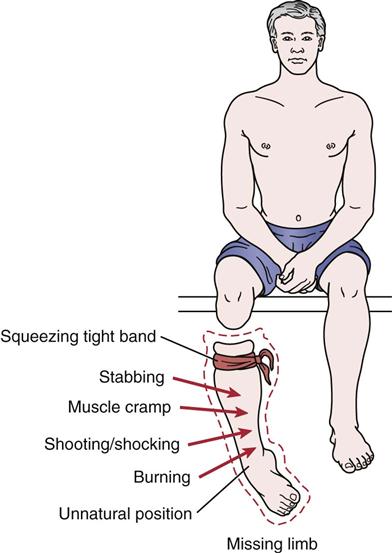
Some of the typical painful feelings that seem to stem from the missing limb. (Redrawn from Sherman RA: Stump and phantom limb pain. Neurol Clin 7:250, 1989.)
Stump pain is pain arising from the residual part of the body as opposed to phantom pain, which is felt in the missing part of the body.22,38,39,41,42 It is commonly a sharp, sticking, or pressure feeling that, although diffuse, is localized to the end of the stump.39 Stump pain is usually the result of six primary etiologies—prosthogenic, neurogenic, arthrogenic, sympathogenic, referred, and abnormal stump tissues.38
Stay updated, free articles. Join our Telegram channel

Full access? Get Clinical Tree









